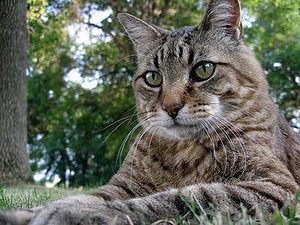A feline genetic study has revealed that a particular gene variation in a cat’s chromosome is responsible for the stripped fur so many cat lovers adore. According to the researchers, the same gene gives cheetahs, the house cat’s larger and wilder cousin, stripes instead of the regular spots.

The research was lead by Stephen O’Brien of the National Laboratory for Cancer Research, who also was part of the team which decoded the entire domestic cat genome back in 2007. An intriguing subject, which was just recently solved, was how exactly did cats get their varied coats, from plain solid colors to tabby narrow stripe or d “mackerel” pattern, as it’s also called.
Using the genetic mapping of the domestic cat’s genome, scientists narrowed their search down to one region of the chromosome containing three large genes. Further filtering by sequencing of both blotched and stripped coated felines reveled that the specific gene in cause is “Taqpep“. Narrow stripes coated cats have a working copy of this gene, while cats with a blotchy “classic” pattern have the gene turned off by a mutation.
The researchers suspect, however, that the gene has a function far useful than simply offering stripes. Apparently the Taqpep gene also holds the blueprint for a molecule usually found on cell membranes and used for passing messages from outside the cell to the inside. These types of membrane molecules are often associated with the immune system. Since this color mutation occurs fairly often among cats, it may be safe to say that it has a role in strengthening cats’ immune system.
“What this is, is the first connection of a gene involved in pattern formation in cats to their molecular status,” said study researcher Stephen O’Brien of the National Laboratory for Cancer Research.
Also, it’s been found that a mutation in the same gene produces the blotches and stripes of the rare “king” cheetah, rather than the spots most cheetahs have. The research itself wasn’t initiated out of a fluke of curiosity in a quest to establish why tabby cats get their stripes. O’Brien said, cat genetics may help researchers understand human disease and genetic development.
Findings were reported in the journal Science.


